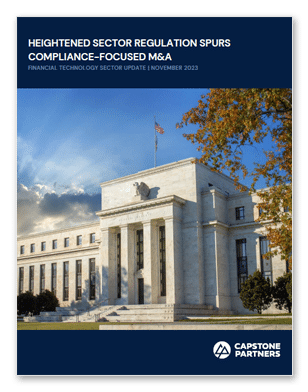Financial Technology M&A Update – November 2023
 Heightened Sector Regulation Spurs Compliance-Focused FinTech M&A
Heightened Sector Regulation Spurs Compliance-Focused FinTech M&A
Capstone Partners released its November 2023 Financial Technology (FinTech) M&A Update, reporting that the FinTech sector has showcased significant strength amidst economic turbulence and heightened regulatory oversight, evidenced by healthy levels of merger and acquisition (M&A) and financing activity through year-to-date (YTD). Regulatory authorities, particularly in the U.S., have increasingly analyzed the FinTech sector to prompt stringent compliance and reduce risk of fraudulent activity, a trend Capstone heard echoed at the 2023 Money20/20 conference. This initiative has been spearheaded by the U.S. Federal Reserve and Securities and Exchange Commission (SEC). Of note, the SEC has identified Emerging FinTech, Anti-Money Laundering (AML), and Regulation Systems Compliance as three key areas of examination for 2024, according to the organization’s 2024 Examination Priorities report. Under this latest SEC provision, sector participants will be required to routinely review, update, and enhance their compliance practices in accordance with SEC’s custody processes, valuation procedures, compliance reviews, and the Bank Secrecy Act (BSA). Although the long-term impacts of heightened regulation have remained uncertain, this shift has recently spurred compliance-focused transactions in the CFO Stack, Financial Services Infrastructure, and Payments subsectors.
Global M&A volume in the FinTech sector has continued to mirror prior year levels with 748 transactions announced or completed in YTD Q3 2023. This marks a modest decline of 2.2% from YTD Q3 2022 (765 deals). Although full-year 2023 dealmaking will likely fall short of 2021’s peak, further consolidation is expected as M&A has become a key strategic option for mature FinTech providers seeking to gain market share. FinTech M&A volume in North America has fallen 4.3% year-over-year (YOY) through Q3, registering a slightly deeper decline compared to the international market (-0.9% YOY), likely driven by heightened M&A regulations from U.S. governing bodies. Private strategic buyers have continued to comprise the lion’s share of deal activity to-date, accounting for 50.5% of sector M&A volume. However, private equity firms have maintained interest in the space, namely through add-on deals (20.6% of sector transactions to-date).
Average sector M&A purchase multiples have remained healthy despite global economic challenges and a downturn in M&A volume. In YTD 2023, sector M&A transactions have averaged 5.8x EV/LTM Revenue, marking an uptick from YTD 2022. Although average purchase multiples have been uplifted by large-scale transactions, middle market participants (less than $500 million enterprise value) have continued to comprise an overwhelming majority of FinTech sector deal activity, accounting for 80.8% of disclosed transactions to-date. Additionally, FinTech middle market purchase multiples have averaged 5.4x EV/LTM Revenue in YTD 2023.
Also included in this report:
• Capstone’s FinTech Front Runners, a series of FinTech startups that have exhibited exceptional leadership and revenue growth.
• Why the lion’s share of North America-based FinTech CEOs polled in Capstone’s 2023 Middle Market Business Owners Survey plan to execute growth strategies in 2024.
• Key themes from the 2023 Money20/20 conference and how these are slated to impact M&A and financing markets in the sector.
• How the CFO Stack, Financial Services Infrastructure, and Payments subsector M&A markets have been impacted by stringent regulation amendments.
• Why venture capital firms have become increasingly selective in capital allocation and how this has affected FinTech financing activity through YTD.
Related Transactions
Insights for Middle Market Leaders
Receive email updates with our proprietary data, reports, and insights as they’re published for the industries that matter to you most.








